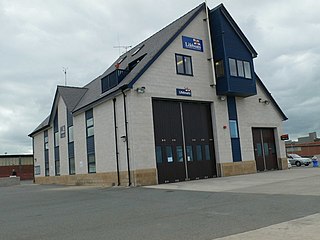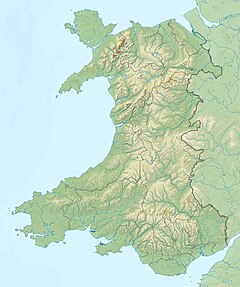
Tenby Lifeboat Station is a lifeboat station in Tenby, Pembrokeshire, Wales that has been situated to the east of the town since 1852, three generations having been built; the original and updates in 1905 and 2005. The station currently houses two lifeboats.

Walmer Lifeboat Station is located on The Strand on Walmer promenade, in the county of Kent.

Wells-next-the-Sea Lifeboat Station is located at the end of Beach Road, about 1 mi (1.6 km) north of the town of Wells-next-the-Sea, on the north coast of the English county of Norfolk.

Barry Dock Lifeboat Station is located at the Pierhead Buildings, at Barry Dock Outer Harbour, near the town of Barry, in the Vale of Glamorgan, Wales.

Sennen Cove Lifeboat Station is the base for Royal National Lifeboat Institution (RNLI) search and rescue operations for the sea around Land's End, Cornwall in the United Kingdom. The first lifeboat was stationed at Sennen Cove in 1853. Since 2009 it has operated a Tamar-class all-weather boat (ALB) and a D-class (IB1) inshore lifeboat (ILB).

Llandudno Lifeboat Station is located in the town and seaside resort of Llandudno, sitting on the Creuddyn peninsula, in Conwy County Borough, North Wales.

Fishguard Lifeboat Station in located on the quay, at the northern breakwater of Fishguard Harbour, in the community of Fishguard and Goodwick, in the county of Pembrokeshire, Wales.

Aldeburgh Lifeboat Station is located in the town of Aldeburgh, in the English county of Suffolk.

Rhyl Lifeboat Station is operated by the Royal National Lifeboat Institution (RNLI) in the North Wales town of Rhyl. For over 150 years, the Lifeboat Crew in Rhyl have been saving lives at sea. The first lifeboat was stationed in the town in 1852 and the present station was opened in December 2001. The station operates a Shannon-class All-weather lifeboat (ALB), and an D-class (IB1) Inshore lifeboat (ILB).

Cardigan Lifeboat Station is located at Poppit Sands, on the southern side of the River Teifi estuary in North Pembrokeshire, approximately 3 miles (4.8 km) north-west of the town of Cardigan, Wales.

Skegness Lifeboat Station is located at Tower Esplanade, in the town of Skegness, on the east coast of England, south of the Humber Estuary and north of The Wash, in the county of Lincolnshire.

Selsey Lifeboat Station is a Royal National Lifeboat Institution (RNLI) station located in Selsey, West Sussex on the south coast of England.

Littlehampton Lifeboat Station is located in the town of Littlehampton, in West Sussex, on the south coast of England. The station is on the harbour side on the eastern bank of the River Arun, a quarter mile from the harbour entrance and the pier. The current lifeboat house on Fisherman's Quay was built in 2002.

Shoreham Harbour Lifeboat Station is a Royal National Lifeboat Institution (RNLI) station located in the town of Shoreham-by-Sea in the English county of West Sussex.

Eyemouth Lifeboat Station is located at the harbour town of Eyemouth, in the Scottish Borders, Scotland.

Moelfre Lifeboat Station is located in the village of Moelfre, on the north east coast of Anglesey, Wales.

Barmouth Lifeboat Station is located in Barmouth, a town at the mouth of the Afon Mawddach river in Gwynedd, Wales. A lifeboat was first stationed here by the Royal National Institute for the Preservation of Life from Shipwreck (RNIPLS) in 1828.

Anstruther Lifeboat Station is a Royal National Lifeboat Institution (RNLI) station located in the town of Anstruther, Fife. The station has been in operation since 1865, although RNLI activity in the area dates back to 1832.

Clacton-on-Sea Lifeboat Station is located on Hastings Avenue, in the seaside town of Clacton-on-Sea, on the Tendring peninsular, in the county of Essex.
Alderney Lifeboat Station is located at Braye Harbour, on the island of Alderney, the northernmost of the inhabited Channel Islands. It is part of the Bailiwick of Guernsey, a British Crown dependency.






















